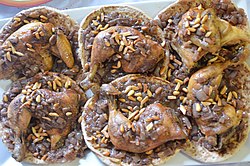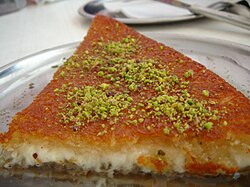This article has multiple issues. Please help improve it or discuss these issues on the talk page . (Learn how and when to remove these messages)
|

Levantine cuisine is the traditional cuisine of the Levant, in the sense of the rough area of former Bilad al-Sham (the Arabic term for the Levant region). The cuisine has similarities with Egyptian cuisine, North African cuisine and Ottoman cuisine. It is particularly known for its meze spreads of hot and cold dishes, most notably among them Manakish pies, kibbeh , ful medames , hummus , tabbouleh and baba ghanoush , accompanied by bread. [1]








